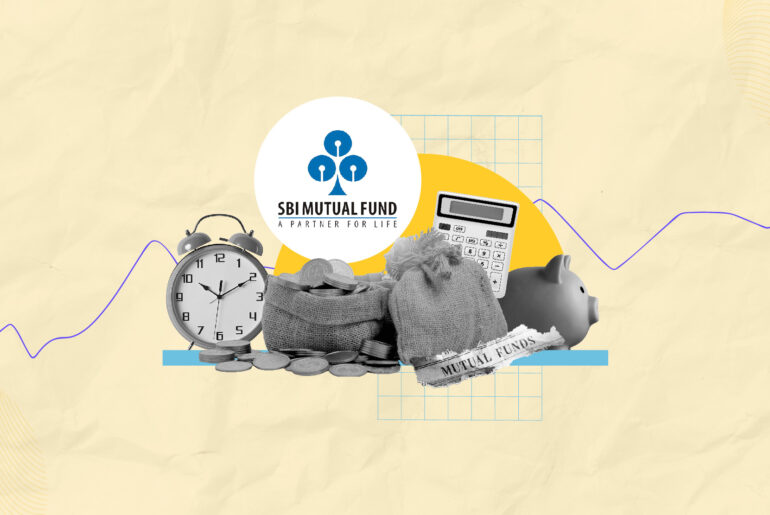Last Updated on May 18, 2023 by Vyshakh
‘The Nifty is up today‘ – You might have heard this before, but have you ever wondered what it means and which index they are talking about? Nifty50, Nifty100, Nifty Next 50 – there are so many. Well, to clear the confusion, they are talking about Nifty50. In this article, let’s explore Nifty50, its history, stocks with its weightage, sector-wise distribution, and how to invest in Nifty50.
Table of Contents
What is Nifty50?
The Nifty50 is an index of the National Stock Exchange (NSE) comprises of the top 50 companies of India by market capitalisation, hence the name. This index is used by investors along with Sensex, an index of 30 companies of the Bombay Stock Exchange (BSE), to gauge the market performance. So, when someone says ‘The market was up today’, it usually means the Nifty50 was in the uptrend.
For foreign investors tracking the Indian stock market, the Nifty index and its movement is their reference point.
History of Nifty50
Introduced in 1996, the Nifty50 is India’s first index tracking the performance of the top 50 stocks listed on the NSE. Since then, the Nifty index has become a benchmark index for Indian equities. It was launched with a base value of 1,000 which has grown to ~17,662.20 as of 7th February 2023. Over the years, the Nifty50 has become the most widely tracked index in India and is used by a variety of investors for benchmarking their portfolios.
In December 2018, NSE launched the Nifty500, an expanded version of the Nifty50, which includes 500 stocks from various sectors. Now, let’s look at the 50 stocks of Nifty50.
Nifty50 stocks
The Nifty50 comprises stocks from various sectors, including banking, IT, consumer goods, energy, pharmaceuticals, and more. The list of stocks under Nifty50 is as follows:
| Company Name | Industry | Weightage |
| Adani Enterprises Ltd | Metals & Mining | 1.04 |
| Adani Ports and Special Economic Zone Ltd | Services | 0.59 |
| Apollo Hospitals Enterprise Ltd | Healthcare | 0.56 |
| Asian Paints Ltd | Consumer Durables | 1.58 |
| Axis Bank Ltd | Financial Services | 3.02 |
| Bajaj Auto Ltd | Automobile and Auto Components | 0.55 |
| Bajaj Finance Ltd | Financial Services | 2.01 |
| Bajaj Finserv Ltd | Financial Services | 0.93 |
| Bharat Petroleum Corporation Ltd | Oil Gas & Consumable Fuels | 0.43 |
| Bharti Airtel Ltd | Telecommunication | 2.47 |
| Britannia Industries Ltd | Fast-Moving Consumer Goods | 0.65 |
| Cipla Ltd | Healthcare | 0.71 |
| Coal India Ltd | Oil Gas & Consumable Fuels | 0.6 |
| Divi’s Laboratories Ltd | Healthcare | 0.54 |
| Dr Reddy’s Laboratories Ltd | Healthcare | 0.67 |
| Eicher Motors Ltd | Automobile and Auto Components | 0.58 |
| Grasim Industries Ltd | Construction Materials | 0.77 |
| HCL Technologies Ltd | Information Technology | 1.52 |
| HDFC Bank Ltd | Financial Services | 9.06 |
| HDFC Life Insurance Company Ltd | Financial Services | 0.73 |
| Hero MotoCorp Ltd | Automobile and Auto Components | 0.46 |
| Hindalco Industries Ltd | Metals & Mining | 0.88 |
| Hindustan Unilever Ltd | Fast-Moving Consumer Goods | 2.95 |
| Housing Development Finance Corporation Ltd | Financial Services | 6.06 |
| ICICI Bank Ltd | Financial Services | 7.44 |
| ITC Ltd | Fast-Moving Consumer Goods | 3.98 |
| IndusInd Bank Ltd | Financial Services | 0.9 |
| Infosys Ltd | Information Technology | 7.2 |
| JSW Steel Ltd | Metals & Mining | 0.87 |
| Kotak Mahindra Bank Ltd | Financial Services | 3.22 |
| Larsen & Toubro Ltd | Construction | 3.29 |
| Mahindra & Mahindra Ltd | Automobile and Auto Components | 1.69 |
| Maruti Suzuki India Ltd | Automobile and Auto Components | 1.52 |
| NTPC Ltd | Power | 1.04 |
| Nestle India Ltd | Fast-Moving Consumer Goods | 0.87 |
| Oil and Natural Gas Corporation Ltd | Oil Gas & Consumable Fuels | 0.72 |
| Power Grid Corporation of India Ltd | Power | 0.95 |
| Reliance Industries Ltd | Oil Gas & Consumable Fuels | 10.41 |
| SBI Life Insurance Company Ltd | Financial Services | 0.7 |
| State Bank of India | Financial Services | 2.72 |
| Sun Pharmaceutical Industries Ltd | Healthcare | 1.43 |
| Tata Consultancy Services Ltd | Information Technology | 4.41 |
| Tata Consumer Products Ltd | Fast-Moving Consumer Goods | 0.56 |
| Tata Motors Ltd | Automobile and Auto Components | 1.04 |
| Tata Steel Ltd | Metals & Mining | 1.24 |
| Tech Mahindra Ltd | Information Technology | 0.81 |
| Titan Company Ltd | Consumer Durables | 1.27 |
| UPL Ltd | Chemicals | 0.52 |
| UltraTech Cement Ltd | Construction Materials | 1.05 |
| Wipro Ltd | Information Technology | 0.76 |
Note: The data is taken from NSEIndices. It is as of the 31st January 2023.
What is the weightage in the Nifty50 index?
The weightage of a stock is a combination of the market cap and free float. It refers to the proportion or percentage of a particular stock in the index. It reflects the importance of that stock in the index and how it contributes to the overall performance of the Nifty index. In other words, weightage represents the relative significance of a stock in the index.
A stock with a higher weightage has a greater impact on the index’s overall performance and vice versa. Hence, in Nifty50, Reliance Industries Ltd holds maximum weightage and, thus, impacts the index significantly more than other stocks.
Here’s the sector-wise distribution of stocks in the Nifty50 as of 31st January 2023.
How to Invest in Nifty50 stocks?
There are four ways to invest in Nifty50 stocks. Let’s explore each one of them below.
Take the ETF route
Exchange Traded Funds (ETFs) evolved from mutual funds. As with mutual funds, ETFs pool money from multiple investors to buy a basket of stocks. ETFs, however, can be bought and sold on a stock exchange at any time during market hours at market prices. Equity ETFs track the performance of Nifty50 and similar indices.
To invest in the Nifty50 index, ETF can be one of the ways. Nippon India ETF Nifty BeES, SBI-ETF Nifty 50 and ICICI Prudential Nifty ETF are a few examples of ETFs that track the performance of Nifty50.
Invest in index funds
Index funds are mutual funds that invest in securities that are part of a benchmark index such as Nifty50. By definition, index funds and ETFs sound similar. However, they are different in structures, buying and selling methods, and management fees. For instance, index funds can only be bought or sold at the end of the trading day at the Net Asset Value (NAV) price, which is calculated based on the value of the underlying stocks. However, ETFs can be bought or sold at any time during market hours at the market price, which can fluctuate throughout the day.
Investing in index mutual funds is one of the best ways to invest in Nifty50. The benefits of investing via an index fund are that you will have a lower capital outlay, have a professionally managed portfolio, and aren’t required to constantly monitor it. UTI Nifty 50 Index Fund, ICICI Pru Nifty 50 Index Fund and Nippon India Index Fund-Nifty 50 Plan are a few examples of index funds that track the performance of Nifty50.
Invest via derivatives
Futures and Options are financial instruments that are used to speculate on the future price of an underlying asset, such as the Nifty50 index. When you invest in futures or options contracts based on the Nifty50, you are essentially betting on the future performance of the index. If you believe the Nifty50 will rise in value, you can buy a futures contract or a call option. If you believe the Nifty50 will fall in value, you can sell a futures contract or a put option.
One advantage of futures and options is that they allow you to leverage your investment, meaning you can potentially make larger gains or losses based on a smaller investment. However, this also means that the potential for loss is much greater.
Invest in stocks directly
You can directly invest in the stocks that make up the Nifty50 index in the exact same weightage. However, buying individual stocks will require you to rebalance your portfolio at certain time intervals. Though this method gives you more control over your investment portfolio, it is tedious, time-consuming and complex.
Use Tickertape to enhance your portfolio
Tickertape is your one-stop solution for Indian stock market research, analysis and investment needs. You can track the performance of an index like Nifty50, individual stocks, mutual funds, ETFs, and your portfolio. Our new portfolio update allows you to view your top holdings and their weightage in your portfolio in a jiffy, identify stocks with potential red flags in your portfolio, and more. Read about it here.
Loaded with over 200 filters, Tickertape Stock Screener makes your analysis smooth and the investment process quicker. There are 18 pre-built screens based on different investment objectives and an option to build your custom screen and the stock universe. Along with making analysis easier and quicker, Tickertape smoothens your investment process as well. Link your broker account and invest directly from the platform. It is as easy as it sounds. Try it now!
Conclusion
‘The Nifty50 was in an uptrend today!’ Now, if you hear this, you know what they are talking about. Investing in the Nifty50 can be an easy task if you get your investment objective, well-researched data, and investment avenues in place. It is always worthwhile to take the help of a financial advisor before making any investment decisions. And for all of your research, analysis and investment needs, #TickertapeHaiNa!
FAQs
Is Nifty50 a good investment?
The Nifty50 has shown immense growth since its inception. It has given over 1,000% returns since the year 2000. However, before investing in any avenue, there are more factors to consider other than returns, such as your investment objective, investing amount, inflation, risk tolerance, and more. Hence, it is always worthwhile to consult a financial advisor before investing.
Can I buy Nifty50 in Zerodha?
To trade Nifty50 with Zerodha, you can use either the Kite website or the Kite mobile app. You can do it via Futures and Options (F&O). Before engaging in Nifty options trading, it is important to ensure that the F&O segment is activated for your account.
How to invest in Nifty50 for the long term?
To invest in Nifty50 for the long-term, you can choose ETFs, index funds, or invest in the Nifty50 stocks directly. Consider your investment objective and risk appetite before investing in any of the investment options.
- Best High Dividend Paying Mutual Funds in India (2025) - Apr 22, 2025
- Best Hybrid Funds in India – Types, Examples & Advantages - Apr 22, 2025
- Best High Return Mutual Funds in India This Year Based on CAGR - Apr 22, 2025




